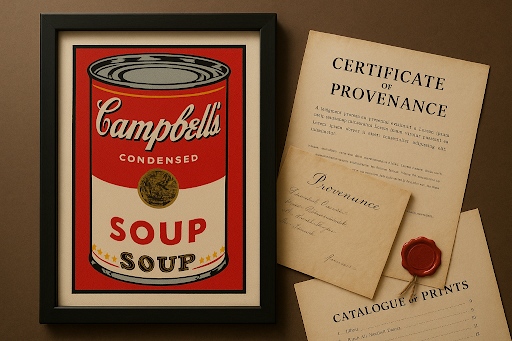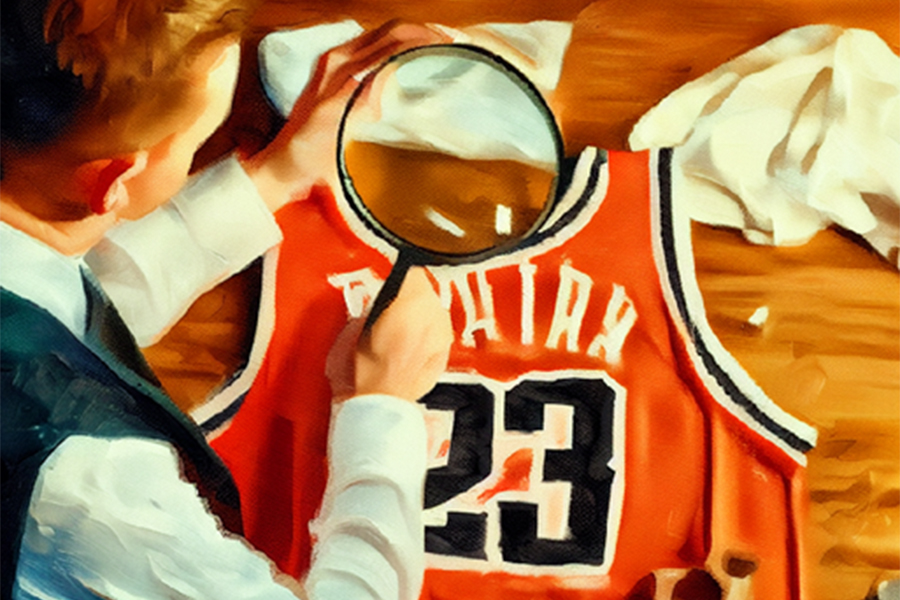Destiny Family Office works with ultra-high-net-worth collectors, offering services tailored to their investments, families, and passion assets. By understanding what’s most important to you, we can help you navigate complexity, simplify your life, and achieve peace of mind.
If you have a valuable collection you’d like to include in your financial, tax and estate planning, contact our Destiny Family Office team today. And don’t forget to self-assess your planning to date by completing our Collectibles Scorecard.
There are few words more consequential in high-end collecting than provenance.
That word represents the difference between an ordinary item and one worth tens of thousands times more. Between an otherwise pedestrian work and a piece of collecting lore. Between an item of unknown origin and one used by an all-time great.
So what is provenance, why should high-net-worth collectors care about it, and how can it impact a collectible asset’s value?
What is provenance?
Provenance refers to the chain of ownership for an item, ideally tracing back to its origin. For works of art, the origin would be the artists themselves. For a piece of sports memorabilia, the origin would be the player who used or wore it, with custody often obtained from the player’s team or league.
How is provenance tracked?
At the high end of the art market, provenance is tracked through research and extensive record-keeping. It’s common to see provenance thoroughly detailed in auction listings for these high-end items. Those lists of prior owners might show the journey from the work’s initial gallery to a private collection to sale at public auction (with the date, event, and lot number included), to the present owner. With this information, bidders can understand when the work was last available for public bidding, how frequently it has changed hands, and what halls it might’ve graced through the years.
Of course, not all categories of collectibles treat provenance with the same rigor.
In cultural memorabilia, paper letters or certificates of authenticity often accompany items said to be used or worn by star musicians or athletes. These documents attest to the item’s use, stating the case for provenance to the celebrity. The most credible documents include a signature from the celebrity or a very close associate or family member.
Why does provenance matter?
Ironclad provenance is an essential pillar of authenticity for myriad collectible assets. For artwork, a definitive chain of ownership stretching from the current collector or institution back to the origin with the artist heightens the work’s credibility. The same concept applies to pieces of cultural memorabilia. In both cases, that first link in the chain, from origination to the market, is of the utmost importance.
Items purported to be from an artist or used by a celebrity often find their way to market in a cloud of mystique, with little or no credible attestation supporting their authenticity. Such items invite immediate skepticism, whereas those boasting robust provenance provide a prospective collector with greater confidence in the item’s authenticity and its procurement via legal and rightful means.
For instance, an item marketed as a “Michael Jordan Game-Worn Jersey” with no associated documentation or detail on its sourcing will likely attain significantly lower prices than a jersey with those attributes. Market participants’ treatment of the mysterious item may compare more closely to any old off-the-rack jersey than those jerseys authenticated to the highest standard.
Adventurous collectors may view such a jersey as a lottery ticket, purchasing it in hopes of establishing stronger provenance or achieving more credible authentication. However, the lower price reflects the slim probability of that happening.
Provenance doesn’t matter only as a pillar of authenticity. Prior ownership by esteemed collectors can also indicate to the market that the item is desirable, a phenomenon we’ll discuss in greater detail momentarily.
Check it out: On our Significance of Wealth podcast, Daniel Sedwick, an expert in shipwreck artifacts and treasure coins details the importance of provenance in the category. He explains the necessity of a clean paper trail demonstrating that an item was legally obtained, as well as the tarnished reputation of items found during the scuba diving boom of the ‘60s and ‘70s, when an emphasis on provenance went by the wayside.
How can provenance add to an item’s value?
Provenance can materially impact an item’s value, even turning mundane possessions into five-figure collectibles. Prior ownership by celebrities, prestigious institutions, and reputable collectors can act as a tailwind to value, as can prominent display.
Celebrity Provenance
Naturally, those game-worn or stage-used items owned by our cultural superstars, with clear links to that ownership, fetch top dollar at auction. But it’s not just those items that saw the brightest spotlight that can soar to higher values because of their provenance.
As an example, look no further than the multi-part auction of Freddie Mercury’s estate at Sotheby’s. The week of auctions was a prolonged outpouring of global admiration for the late singer, with fans competitively bidding to own a keepsake from his life. While the instruments, handwritten lyrics, and colorful stage-worn outfits enjoyed significant demand, mundane items were also wildly desirable. Case in point: Mercury’s silver Tiffany & Co. moustache comb sold for £152,400. No commas were misplaced or decimal points omitted.
Or consider another musical icon, Elton John, this time weighing the appetite for items that already boast immense value: his watches. Sir Elton’s 1991 18K Gold Cartier Crash sold for $277,200 at Christie’s, multiples above its $70,000 – $100,000 estimate and comfortably ahead of recent examples in the low $200,000 range. His “Leopard” Rolex Daytona generated similar results, selling for $176,400 against an estimate of $40,000 – $60,000. Comparable examples seldom cross $100,000, if ever.
Institutional Provenance
While the initial link in the chain of ownership, at the originator, is most important, subsequent links can also contribute to future value. For instance, inclusion in the collection of an esteemed museum can drive higher appeal and prices.
A museum’s choice to own and exhibit an item serves as a co-sign for the item’s cultural relevance. In the case of prestigious museums, that co-sign comes from a highly credible tastemaker. When a museum must make the difficult choice to sell an item, aspiring bidders take notice. Because museums deaccession items to raise funds, they often sacrifice valuable and desirable pieces, so the decision to sell shouldn’t necessarily be viewed as unloading low-quality filler.
It’s not just the tastemaking co-sign that matters for value, though.
Museums are often the most diligent stewards of assets, utilizing meticulous standards of care and preservation. As many valuable collectible assets are older and require such care, this reputation for diligence is meaningful. For example, the Indianapolis Motor Speedway Museum recently sold 11 rare and historically significant vehicles to raise funds. These cars, historic and intricate pieces of machinery, require incredibly industrious care.
Because of their rarity and historical significance, they would have assuredly fetched handsome sums without the associated provenance. However, because bidders could be confident in the cars’ upkeep and condition, the collection raised over $123 million, including sales of the 2nd and 6th most expensive cars ever sold at auction. In this regard, institutional provenance can offer a co-sign on the item’s cultural relevance and a vote of confidence for its preservation and care to date.
Collector Provenance
We can apply many of the same positive attributes of institutional provenance to collector provenance. When an item boasts provenance to a prolific and reputable collector — a person known to have built an impressive collection with care, diligence, and even expert advisory — the results can be as significant (if not more so) as those with museum provenance. In many ways, as an individual or family’s collection grows to that level of renown, it becomes institutional in nature.
The most compelling recent example of remarkable collector provenance is the 2022 sale of late Microsoft co-founder Paul Allen’s art collection. One auction (in a schedule of many from Allen’s collection) generated more than $1 billion in art sales, becoming the first single-owner event to achieve such a feat. Many works and artists featured in the collection saw material premiums in sales price thanks to Allen’s ownership and the excitement associated with the event.
While items can still flourish at auction without reputable collector provenance, its presence assures interested bidders that the collector has previously vetted the item, admired its importance, and included it among other highly coveted pieces.
Exhibition Provenance
Provenance sometimes focuses not just on ownership but on custody. While the ownership of an item might not change, its travels — on loan or otherwise — to prestigious shows, exhibitions, museums, or fairs can be an alluring signal for collectors. These appearances provide further co-signs of an item’s cultural relevance and desirability, often driving increased value.
Notably, these occasions also boost an item’s visibility.
Thousands of visitors might see the item daily, bringing it further to the forefront of conversation and collector consciousness. To the extent it’s displayed alongside other high-caliber items, its reputation will grow by association through inclusion in that club. That visibility, even if short-lived, can leave a lasting impression that bidders acutely recall when an item crosses the auction block.
Provenance is a nuanced concept in the world of collecting, with the ability to enhance an item’s credibility and materially impact its value in myriad ways. By thoroughly understanding it, high-net-worth collectors can make more informed decisions in the purchase and sale of treasured assets.
Over time, they might craft a collection so remarkable in size and quality that it boasts its very own value-added provenance.
Destiny Family Office works with ultra-high-net-worth collectors, offering services tailored to their investments, families, and passion assets. By understanding what’s most important to you, we can help you navigate complexity, simplify your life, and achieve peace of mind.
If you have a valuable collection you’d like to include in your financial, tax and estate planning, contact our Destiny Family Office team today. And don’t forget to self-assess your planning to date by completing our Collectibles Scorecard.




